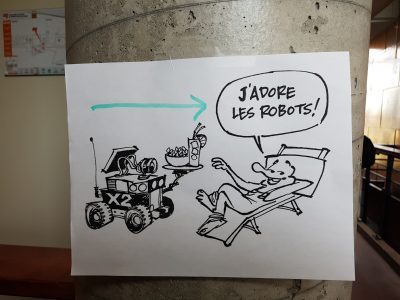
at the University of Quebec at Abitibi and Temiscamingue. However, the author believes the future is not just about robots. (Image: Maya Ganesh, 2017)
It seems like there is a flowering of interest in speculating about the future. Of course SF writers, the RAND Group, and Trekkies, have been doing this for much longer. (An interesting side note: SF writers are now enjoying new income streams by working with multinational corporations to imagine the future.)
It is possible that as consumer technologies began to appear as if from ‘the future’, as presented to us in dystopian movies such as Bladerunner and Minority Report, speculating about the future increasingly became a topic of interest. As the phrase ‘surveillance capitalism’ has gained visibility thanks to devices just as the Echo. And maybe things started to appear ‘Orwellian’ after the Snowden revelations. I would like to think that Intergovernmental Panel on Climate Change reports generate concern about the future; but the continued rising temperature of the planet suggests that this is not the case. Possibly for people in the US, the election of Donald Trump, for Brazilians of Jair Bolsonaro, The Future has become a thing to be worried about (‘now more than ever’).
I spent last weekend at a workshop called Designing Tomorrow organised by the great folks behind the Utopia Film Festival in Tel Aviv, and re:publica in Berlin. The workshop was about testing various methodologies to actually speculate about the future; and they drew heavily from Peter Frase’s Four Futures. It got me thinking about the different narratives to thinking about the future. Here is a quick overview of some of these that I’ve encountered through recent arts and culture projects, and in the tech news (These do not necessarily line up as perfectly nested Russian dolls, however.)
- The planet is a mess! Things are going extinct! Life as we know it is over! We can do nothing to stop it, except to come up with a beautifully designed ending.
- So let us use reason, rationality and technology to transcend the mortal coil and start over on Mars.
- But why are we talking about extinction as a something about the future when it is already happening? Like, for example, a million indigenous people in India were just evicted from the forests that they have always lived in. This has “resurrected an old debate between forest rights groups and the conservation lobby.” The future is actually the past.
- Framed in terms of both the future and a catastrophic present, theorist Orit Halpern’s Planetary Futures Summer School project asked: “how we might imagine, and design, a future earth without escaping or denying the ruins of the one we inhabit? How shall we design and encounter the ineffable without denying history, colonialism, or normalizing violence? What forms of knowledge and experiment might produce non-normative ecologies of care between life forms? How shall we inhabit the catastrophe?” (Projects here)
- Mushon Zer-Aviv says we need to consider Canceling the Apocalypse in favour of a different perception of the future(s). We need “to think beyond our dark visions, beyond Silicon Valley’s techno determinism, beyond dystopian dreams, beyond the resistance framework that leaves us always playing defence… we will reignite our political imagination… we will explore the futures as an open set of political possibilities rather than a predetermined algorithmic prediction.” .
- One of the ways Mushon and his collaborator Shalev Moran have done this is through their Speculative Tourism project, a set of audio guides taking you through a Jerusalem 50 years into the future as imagined by a group of authors and artists.
- What you imagine is what you get, argue Mushon and Shalev. In terms of a planetary future, what if we imagined something “digitally inclined but unafraid of dirt. Think post-apocalyptic hacker aesthetics, but with a sunnier disposition.” Enter: Solarpunk.
- Another set of people are doing the work of creating new political imaginaries. They are thinking about the future in terms of the world we want, and have, now, rather than about the persistent theme of exit. Who gets to exit, as Sarah Sharma might ask? Octavia’s Brood is an anthology of ‘visionary fiction’ because it “pulls from real life experience, inequalities and movement building to create innovative ways of understanding the world around us, paint visions of new worlds that could be, and teach us new ways of interacting with one another.”
- This is a theme echoed by other fellow travelers who ask why have certain narratives been privileged over others? Situated at the intersection of Art, Science and Technology they ask, what it would look like if “feminist, queer, de-colonial, disabled and historically marginalized artists…offer visions of the future outside and beyond the dominant discourse…” Might we find new possibilities of “Re-figuring The Future?
- Narratives about speculation about the future are situated. What do Asian speculations about the future look like?
- And critically, Ingrid Burrington asks how speculating about the future has been used and abused. How might the ‘inevitabilities of certain doom’ contained in the notion of a Future Perfect be challenged? How might “life find a way”?
What narratives about speculative futures are you noticing where you are?
*Thanks to participants at the Designing Tomorrows workshop who contributed some of these links at the workshop and in the group’s Slack channel.
Maya Ganesh is a technology researcher and writer living in Berlin. She is working on a PhD about how automated decision-making is playing out against the backdrop of future imaginations of machine autonomy. She may be found on Twitter @mayameme
